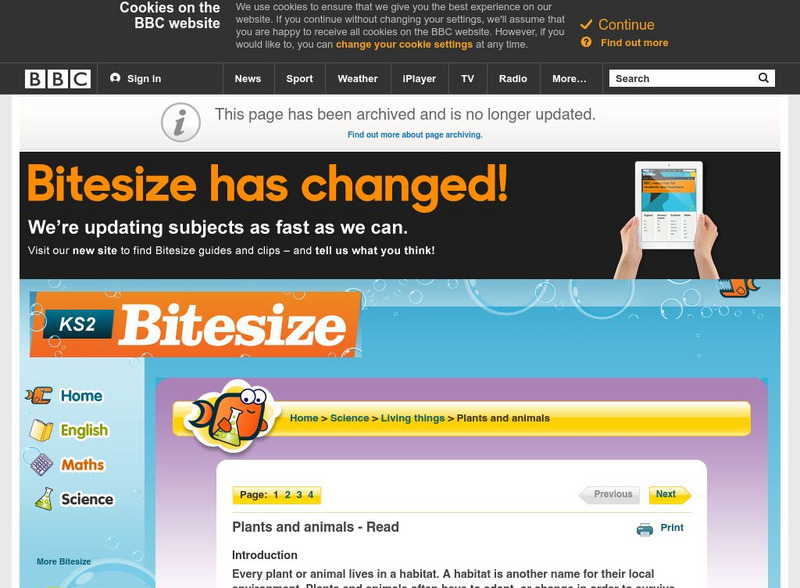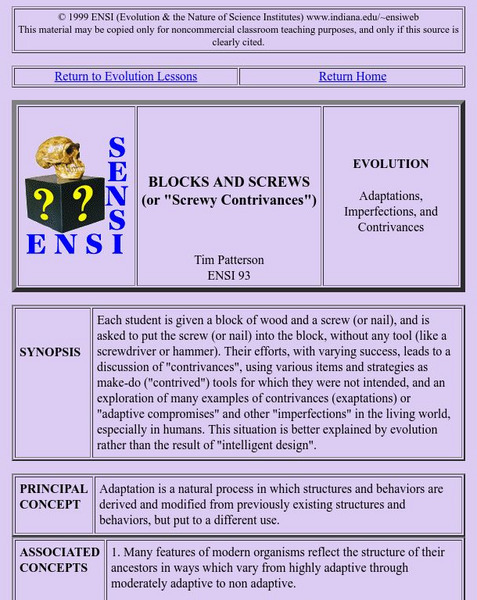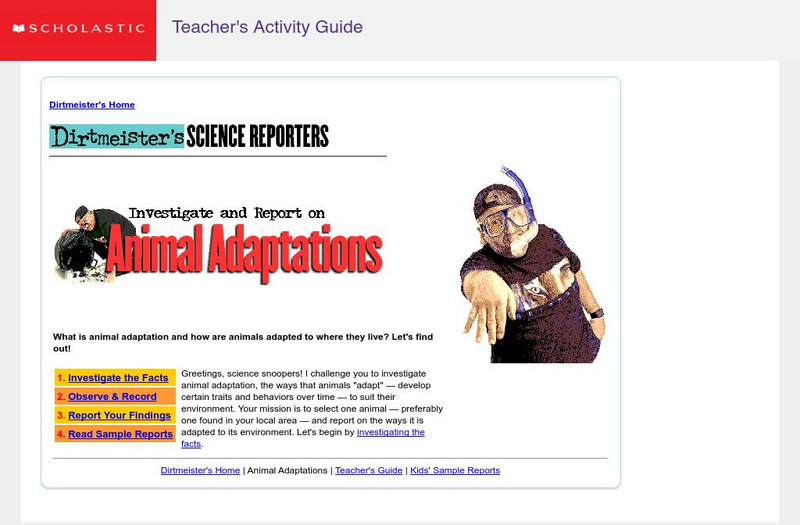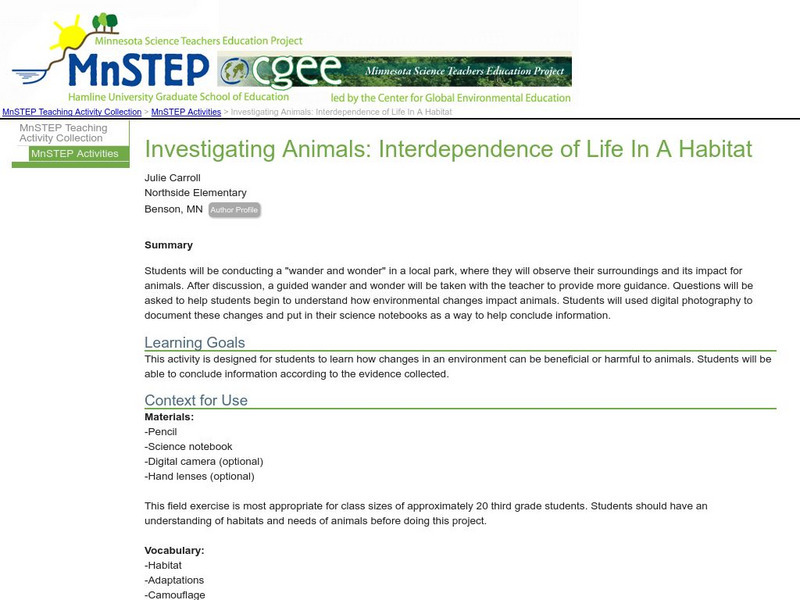Utah Education Network
Uen: Life's Different Seasons
Recognize changes in bears and insects and compare them.
Better Lesson
Better Lesson: Survival of the Fittest
Fins, gills, claws, wings, each has a special purpose in helping an animal to survive. Students will look at how animals have different parts that help them to adapt to their habitat, and to avoid predators or capture prey. Included in...
Utah Education Network
Uen: Animal Adaptations
A multitude of activities provide help with understanding animal adaptations.
Utah Education Network
Uen: Trb 4:5 Investigation 3 Web of Life
Understand environments and how organisms adapt to their environment.
Utah Education Network
Uen: Plant and Animal Communities
Learn about the six main classes of the animal kingdom.
BBC
Bbc Schools: Ks2 Bitesize: Science: Living Things: Plant and Animal Habitats
Place the aliens in the habitats where they can survive the best. Following the activity, read more about plant and animal habitats, and then take a quick quiz to check for understanding.
Utah Education Network
Uen: Build a Bug : Bugs Don't Bug Me
Students learn what adaptations macroinvertebrates have in order to live in an aquatic environment.
Utah Education Network
Uen: Trb 4:5 Investigation 5 Desert Dynamics
Fourth graders will understand how plants and animals adapt to their environment.
American Museum of Natural History
American Museum of Natural History: Crazy Camouflage
Create a flounder fish that's hard to spot. In this hands-on activity, students gather evidence to explore how camouflage helps animals survive.
Indiana University
Ensi: Blocks and Screws Lesson Plan
The Evolution and the Nature of Science Institute offers lesson plans that investigate the vestigial organs in such a way as to better explain their imperfections as proof of evolution rather than the result of "intelligent design."
E-learning for Kids
E Learning for Kids: Science: Iceland: What Are Adaptations?
Join Ike when he travels in the Arctic to learn about how animals adapt to cold environments.
E-learning for Kids
E Learning for Kids: Science: Nova Zembla Expedition: How Are Different Organisms Suited to Their Habitats?
Alex and Foxy White are walking around looking at animals and learning about their habitats. Join them on their expedition.
PBS
Pbs Learning Media: Ingredients for Life: Water
This video segment adapted from NOVA goes on a whimsical journey in search of life forms thriving in extreme conditions on Earth and in outer space. Animations show ice on Jupiter's moon, Europa, and signs that water once existed on...
PBS
Pbs Learning Media: Night Vision
This interactive feature from the NOVA: "Leopards of the Night" Web site highlights the nighttime habits and abilities of a wide range of nocturnal creatures.
Scholastic
Scholastic: Build Your Own Caterpillar
Choose adaptation features that will help a caterpillar to survive when predators are nearby. Students enter their reasons for choosing the characteristics they did, and receive feedback.
Scholastic
Scholastic: Dirtmeister's Science Reporters: Animal Adaptations
Provides guidelines for doing research on animal adaptations. Provides some examples of adaptations and then provides questions to help students develop a report on a particular animal's adaptations.
PBS
Pbs Learning Media: Wild in the City
Learn about how wild parakeets have adapted to city life in this WILD TV video segment.
Science Education Resource Center at Carleton College
Serc: Investigating Animals: Interdependence of Life in a Habitat
In this activity, students will learn how changes in nature can be beneficial or harmful to animals. At the end, students will be able to conclude information according to the evidence collected.
Science Education Resource Center at Carleton College
Serc: Comparative Anatomy of Bird vs. Human Leg Bones
This activity is designed for students to compare and contrast the anatomy of bird and human leg bones. Students will kinesthetically model walking like a bird to note the differences in the foot bones.
Science Education Resource Center at Carleton College
Serc: Adaptations of Plants for Survival in Different Environments
In this activity, students investigate plant adaptations by observing plants in different environments comparing the plants to show similarities and differences. Students will learn about the adaptations plants need in order to survive...
TED Talks
Ted: Ted Ed: The Game Changing Amniotic Egg
April Tucker peels back each layer of the amniotic egg, revealing how truly extraordinary this evolutionary marvel is. [4:30]
TED Talks
Ted: Ted Ed: Underwater Astonishments
David Gallo shows jaw-dropping footage of amazing sea creatures, including a color-shifting cuttlefish, a perfectly camouflaged octopus, and a Times Square's worth of neon light displays from fish who live in the blackest depths of the...
Other
The Rise of Evolutionary Biology: Biology Before Darwin
These pages are part of a site called "Evolution," that accompanies a textbook by the same name. Mark Ridley is the author. Here he discusses theories for species change that were before Darwin published "On the Origin of Species."
Other
Ernest Hemingway in His Times : A Farewell to Arms
This brief exhibit provides some interesting details about the origin of the novel and its adaptations over time.
















